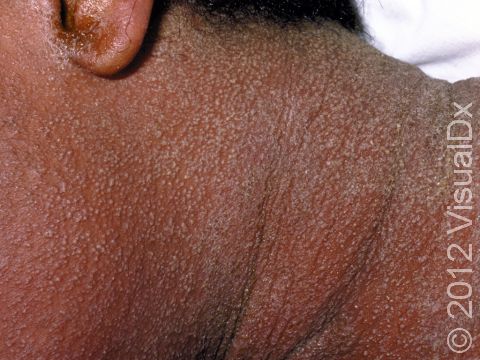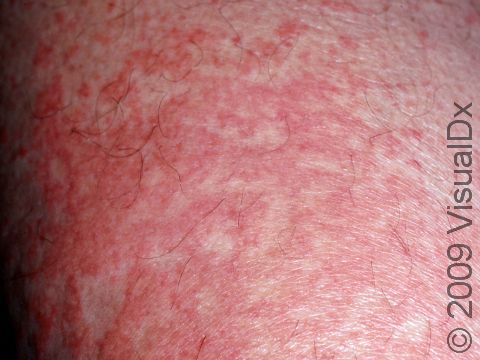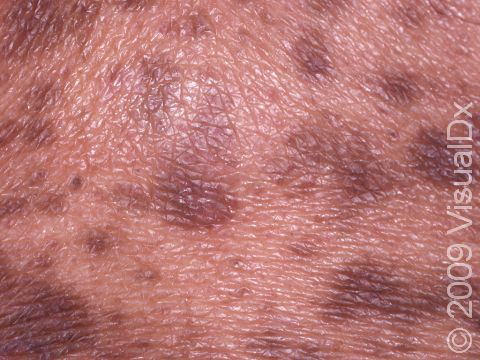Drug Eruption
A drug rash is a skin condition that is caused by a medication. Also known as a drug eruption or drug reaction, it is a wide-varying condition. The drug causing the reaction does not need to be applied to the skin to cause the rash; it can be caused by a drug taken orally. While some drugs may require multiple doses to cause the rash, other drug rashes may occur after a single use. The rash might appear within minutes to days.
Who's At Risk?
Drug rashes are not limited to any sex, age, or race. However, they are more likely to occur in people who have poor immunity (due to a cancer or taking medication that lower one’s immune system). Taking multiple medications can increase the chances of interaction, causing the drug rash. While any drug can cause a rash in a particular individual, some are more likely to than others. These include:
- Blood pressure medications (especially ACE inhibitors)
- Antibiotics (amoxicillin, penicillins)
- Aspirin (aspirin should NOT be given to any child 18 years of age or younger)
- Ibuprofen (Motrin)
- Blood and blood products
- Medications to kill tumor cells (ie, chemotherapy drugs)
- Certain alternative medications, such as echinacea
Signs & Symptoms
Drug rashes can appear as a variety of skin rashes, including pink to red bumps, hives, blisters, red patches, pus-filled bumps (pustules), or sensitivity to sunlight. Drug rashes may involve the entire skin surface, or they may be limited to one or a few body parts.
Itching is common in many drug rashes. However, if fever is present, the skin is tender, or the membranes inside the mouth or the genitalia are involved, then a more serious skin condition may be present.
Self-Care Guidelines
For a widespread or severe drug rash, self-care is not recommended. Call your physician or 911, depending upon the severity of your symptoms.
For a mild or limited drug rash, you may try the following measures:
- Take cool showers or apply cool compresses.
- Apply calamine lotion.
- Take an antihistamine, such as diphenhydramine.
Treatments
If your physician suspects a drug rash, he or she may want to establish the correct diagnosis by performing a biopsy of the lesion. The procedure involves:
- Numbing the skin with an injectable anesthetic.
- Sampling a small piece of skin by using a flexible razor blade, a scalpel, or a tiny cookie cutter (called a “punch biopsy”). If a punch biopsy is taken, a suture or two may be placed and will need to be removed 6–14 days later.
- Having the skin sample examined under the microscope by a specially trained physician (dermatopathologist).
In addition, your doctor may want to perform blood work to look for signs of an allergic reaction.
The best treatment for a drug rash is to stop the medication that is causing it. After discontinuing a medicine, it may take 5–10 days to see an improvement in the skin and up to 3 weeks for the rash to resolve completely.
Note: Stopping a prescription medication should be done only with a doctor’s guidance.
Other treatments that may be helpful include:
- Oral antihistamine pills, such as diphenhydramine, hydroxyzine, loratadine, cetirizine, fexofenadine, or desloratadine, for itching.
- Topical corticosteroid (cortisone) creams or lotions for red, inflamed skin.
- Topical antibiotic ointments for open sores.
Visit Urgency
Whenever you are started on a new medication and develop a rash, you should immediately notify the doctor who prescribed the medicine. If difficulty breathing, rapid heart rate, or the swelling of your tongue, lips, throat, or face accompany the rash, you should seek emergency care.
Prepare a list of all of your medications, including prescription and over-the-counter pills as well as topical creams, vitamins, and herbal or homeopathic remedies for the doctor. Be sure to include medicines that you may take only on occasion. If possible, try to document when you started taking each medication. Also make certain that you know about any previous reactions you might have had to medicines or food.
References
Bolognia, Jean L., ed. Dermatology, pp.333, 336-337. New York: Mosby, 2003.
Freedberg, Irwin M., ed. Fitzpatrick’s Dermatology in General Medicine. 6th ed, pp.1330, 1334-1336. New York: McGraw-Hill, 2003.
Last modified on August 16th, 2022 at 2:45 pm

Not sure what to look for?
Try our new Rash and Skin Condition Finder


